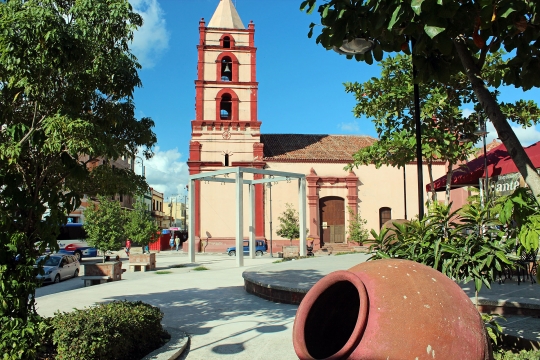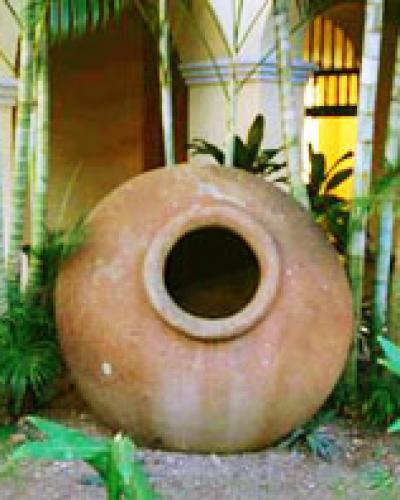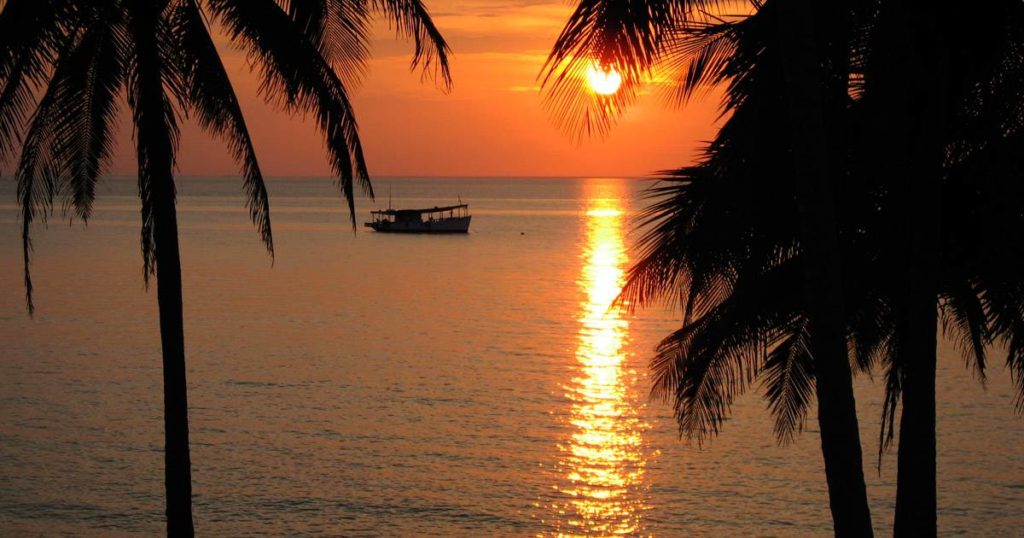The Villa of Santa María del Puerto del Príncipe, once established definitively in the present territory on January 6, 1528, had a serious difficulty with water, which forced the search for a solution.
The Villa was surrounded by abundant clayey earth, excellent quality mud, which constituted the raw material for the first containers destined to store the precious liquid.
Considered a relic in the province of Camaguey due to what it has represented for its inhabitants and the utility it had in time immemorial, the tinajón more than a deposit to store fresh water was one of the first influences received by the land of the Camaguebax of the Spanish especially from Andalusia and that was used there to conserve oils, especially olive oil, hence the conquerors brought the model for our Camagüey. The oral tradition tells that residents of that region settled in these parts and decided to produce these great tools to collect water.
The manufacture of Camagüey jars begins in the early seventeenth century (baked clay); Numerous craftsmen turned their manufacture into a painstaking work of craftsmanship, with decorative details and always with personal ciphers and the date of manufacture.
The tinajones were located in the courtyards of the houses; At the beginning of the spring rains it was expected that the first downpour would clean the roofs and then begin to fill with curious systems of channels, first of wood and then of tin or brass. Once full, some families protected the crest with mosquito netting and covers of the same material as the channel, to prevent mosquitoes from depositing their larvae in the water, which they used preferably to drink and cook.
Through time the precious piece underwent transformations in the crest, belly and its base, in such a way that in many cases, since there are no visible elements to determine its age, the morphological characteristics provide a valuable support for its study.
In addition to being a very appreciated tool in the land of Camaguey, due to the great utility that it showed, the tinajón was also related to the love of the couple and the land that saw them being born and this is remembered by an old adage that says: ” Whoever drinks water from the tinajón remains forever in this place “or also” that young man who drinks water from the tinajón, has to take on a Camagüey woman and stay on this land forever. ”
The legends of the tinajón and its people, denote a close relationship between its inhabitants and traditions that characterize them. They are faithful watchmen of a cultural wealth that frames their architecture, environment and intellectual life, let’s not forget that the national poet of Cuba, Nicolás Guillén is the illustrious son of Camaguey, the city that calls itself “The Land of the Tinajones.”
In the middle of the XIX century, the existence of the tinajones in the houses of the city was considered exaggerated, reason why its manufacture was stopped. In December of 1900 the North American authorities who occupied our Island made an inventory of the tinajones existing in the city of Port-au-Prince, which gave the figure of 16 thousand 483.
This beautiful piece became the symbol that, for decades, represents our city.
CAMAGÜEY, CUBA: LA LEYENDA DEL ‘TINAJÓN’ Y SU GENTE.
La Villa de Santa María del Puerto del Príncipe, una vez establecida definitivamente en el territorio actual el 6 de enero de 1528, tuvo una seria dificultad con el agua, lo que obligó a la búsqueda de una solución.
La Villa estaba rodeada de abundantes tierras arcillosas, barro de excelente calidad, que constituyeron la materia prima para los primeros recipientes destinados a almacenar el preciado líquido.
Considerado una reliquia en la provincia de Camaguey debido a lo que ha representado para sus habitantes y la utilidad que tuviera en tiempos inmemoriales, el tinajón más que un depósito para guardar agua fresca fue una de las primeras influencias que recibió la tierra del Camaguebax de las españolas; especialmente de Andalucía y que allá se utilizaba para conservar los aceites, especialmente el de olivo, de ahí que los conquistadores trajeran el modelo para nuestro Camagüey. La tradición oral cuenta que pobladores de esa región se asentaron por estos lares y decidieron producir estos grandes utensilios para colectar agua.
La fabricación de tinajones camagüeyanos comienza a principios del siglo XVII (barro cocido); numerosos artesanos convirtieron su manufactura en un esmerado trabajo de artesanía, con detalles decorativos y siempre con cifrados personales y la fecha de fabricación.
Los tinajones eran situados en los patios de las casas; al comenzar las lluvias primaverales se esperaba que el primer aguacero limpiara los tejados y luego comenzaban a llenarse mediante curiosos sistemas de canales, primero de madera y después de hojalata o latón.Una vez llenos, algunas familias protegían la cresta con telas de mosquitero y tapas del mismo material que la canal, para evitar que los mosquitos depositaran sus larvas en el agua, la que utilizaban preferiblemente para beber y cocinar.
A través del tiempo la preciada pieza sufrió transformaciones en la cresta, panza y su base, de tal manera que en muchos casos, al no existir elementos visibles que permitan determinar su antigüedad, las características morfológicas brindan un valioso apoyo para su estudio.
Además de ser un utensilio muy apreciado en la tierra del Camaguey, debido a la gran utilidad que ostentó, el tinajón se relacionó también con el amor a la pareja y la tierra que los vio nacer y así lo recuerda un viejo adagio que dice: “El que tome agua del tinajón permanece para siempre en este lugar” o también “aquel joven que tome agua del tinajón, ha de prendarse de una camagüeyana y permanecer en esta tierra para siempre.”
Las leyendas del tinajón y de su gente, denotan una estrecha relación entre sus pobladores y tradiciones que los caracterizan. Son fieles veladores de una riqueza cultural que enmarca su arquitectura, entorno y vida intelectual, no olvidemos que el poeta nacional de Cuba, Nicolás Guillén es hijo ilustre del Camaguey, la ciudad que se autodenomina “La Tierra de los Tinajones.”
A mediados del siglo XIX se consideró exagerada la existencia de los tinajones en las casas de la ciudad, por lo que se detuvo su fabricación. En diciembre de 1900 las autoridades norteamericanas que ocupaban nuestra Isla realizaron un inventario de los tinajones existentes en la ciudad de Puerto Príncipe, el que arrojó la cifra de 16 mil 483.
Esta bella pieza llegó a convertirse en el símbolo que, desde hace décadas, representa a nuestra ciudad.
Agencies/MemoriasCubanas/María Candela/Various/Internet Photos/ Arnoldo Varona/ TheCubanHistory.com
THE CUBAN HISTORY, HOLLYWOOD.









